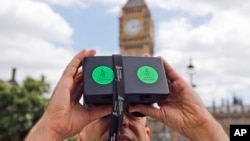The latest frontier in virtual reality could be closer to reality than fantasy.
While video game creators and filmmakers have recreated the likes of Middle-earth and Jurassic World in VR, activist news organization Ryot is teleporting viewers to real-life conflict zones and disaster areas like Nepal and Syria.
Ryot released an immersive short film Tuesday that was shot last month on the war-ravaged streets of Aleppo.
The three-minute film, Welcome To Aleppo, features 360-degree views of abandoned areas in Syria's former commercial center. In one scene, bullets can be heard whizzing past the device used to film the VR footage, while another catches a glimpse of four Syrians on a motorbike traveling down a ruined street.
VR headsets such as Oculus Rift or Project Morpheus won't be available to consumers until next year, but as of Tuesday, the film can be watched and controlled on a computer screen, or with a mobile VR headset, such as Google Cardboard.
VR journalism
For many, VR might not only reshape entertainment but also journalism.
"VR will definitely be used for entertainment, porn, video games, all of that," said Christian Stephen, Ryot's London-based global editor who filmed the video in Syria.
"It can also be used to genuinely communicate stories around the world in desperate need of reaching people," he said. "The fatigue that has come with photos and videos of explosions and people crying has numbed people to the reality of the world, especially in Syria."
Stephen, who has covered conflicts in Iraq and Afghanistan, said capturing the VR footage with a makeshift apparatus — six cameras strapped to a 3D-printed gimbal on top of a tripod — proved much more dangerous than shooting traditional video.
The cumbersome contraption had to be left unattended, and it attracted more attention than a typical camera or smartphone.
"It's an incredibly harsh environment to work in normally, but when they see you running around with a tripod and an alien device on top of it, they are going to try and kill you," said Stephen.
"It looks like some sort of an odd IED. We were basically hunted for eight hours by the regime and rebel snipers. They thought I was trying to set up a bomb because I had to leave it for two to three minutes at a time to film what I wanted," he said.
Deadly conflict
Syria's civil war, now in its fifth year, has killed more than 220,000 people and wounded at least a million people, according to the United Nations.
Three months ago, Ryot released its first foray into VR journalism with footage captured in Nepal after an April 25 earthquake devastated the country. Ryot co-founder Bryn Mooser said the organization is currently working on VR projects in five countries, including the Congo, Uganda, Haiti and Iraq.
"For us, we want to distribute on every single platform," said Mooser. "We just want this story to get out there. It's not about creating a revenue opportunity for people to pay to download this footage. It's about seeing how many people can watch this as soon as possible. As the technology progresses, it'll become easier and easier for people to experience it."
Mooser noted that Welcome to Aleppo marks the first VR video footage to be shot within Syria's war zone. Last year, the Emblematic Group debuted Project Syria, an animated VR experience that recreated an attack on an Aleppo street and transported viewers to a refugee camp.










